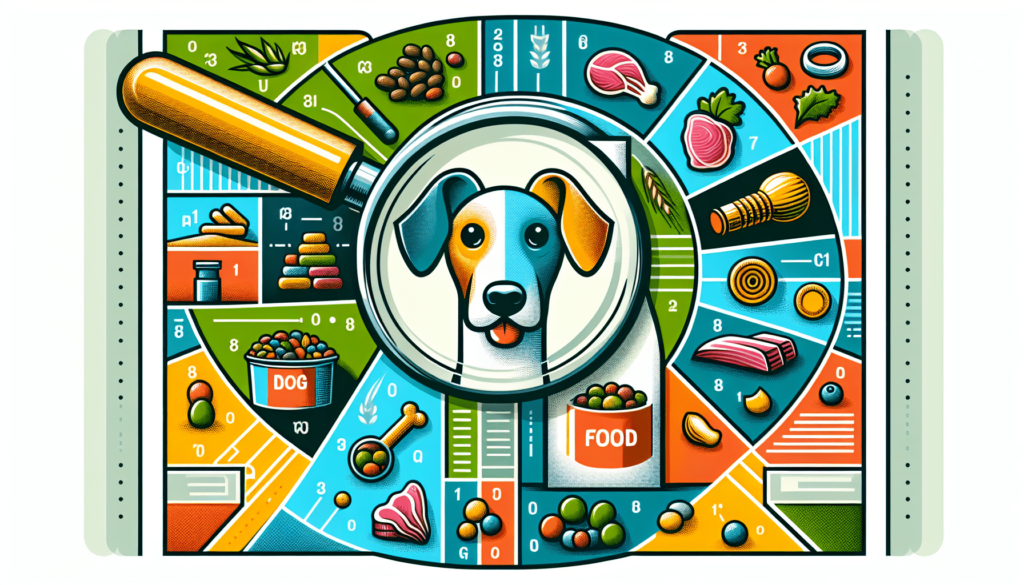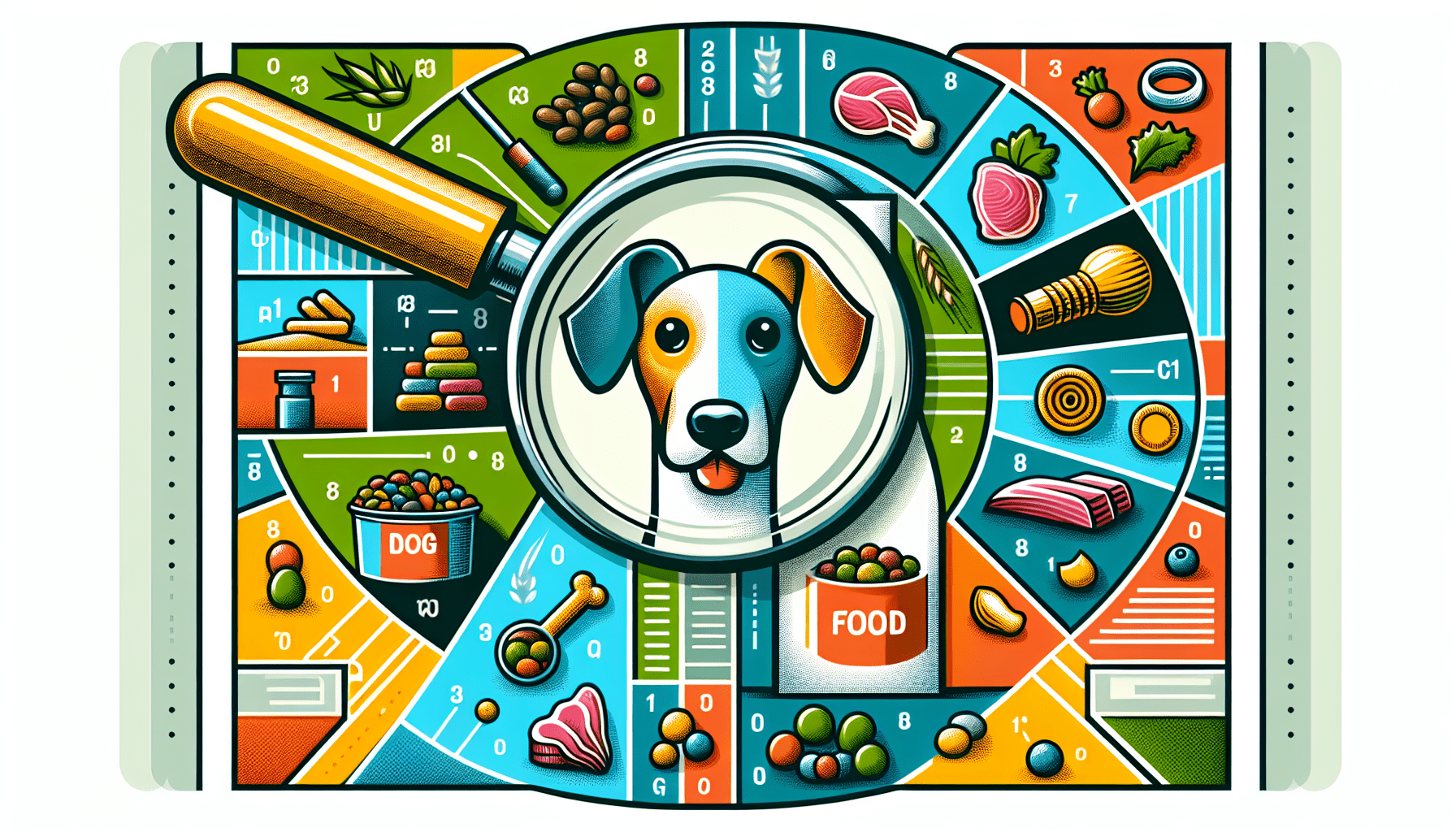In the world of pet food, understanding the labels on dog food can be a bit overwhelming. With so many buzzwords and terms thrown around, it’s hard to decipher what is actually good for your furry friend. That’s why we’re here to help! In this article, we will break down the confusing jargon and explain how to read food labels, ensuring that you make informed decisions about your dog’s nutrition. So grab a treat, get comfy, and let’s uncover the secrets behind dog food labels together!
1. Types of Dog Food
Dry Dog Food
Dry dog food, also known as kibble, is one of the most popular types of dog food available on the market. It is convenient to store and feed, as it has a long shelf life and does not require refrigeration. Dry dog food is often formulated to provide a balanced and complete diet for dogs of all ages and sizes. It also promotes dental health, as the crunchy texture helps to reduce plaque and tartar buildup.
Canned Dog Food
Canned dog food, also referred to as wet dog food, is another common option for dog owners. This type of food generally contains higher levels of moisture than dry dog food, making it more palatable for dogs. Many canned dog foods are also formulated to meet the nutritional needs of dogs at different life stages or with specific health conditions. While canned dog food can be more expensive than dry dog food, it often provides a more appetizing option for picky eaters.
Semi-Moist Dog Food
Semi-moist dog food is a middle ground between dry and canned dog food. It is usually packaged in small, pre-portioned packets or in a resealable bag. This type of dog food has a chewy texture and tends to be more flavorful than dry dog food. However, it may contain higher levels of sugar and artificial preservatives. Due to its higher moisture content, semi-moist dog food has a shorter shelf life than dry dog food.
Raw Food Diet
Raw food diets for dogs, also known as the BARF (Biologically Appropriate Raw Food) diet, consist of uncooked meats, bones, and vegetables. This type of diet is believed to mimic the natural diet of dogs’ ancestors, wolves. Proponents of raw food diets claim that it can improve digestion, increase energy levels, and promote healthier skin and coat. However, it is important to note that feeding a raw food diet requires careful attention to nutrition and food safety, as raw meat can contain harmful bacteria that can be transmitted to both dogs and humans.
2. Understanding Dog Food Labels
When choosing a dog food, it is essential to understand and interpret the information provided on the label. Here are some key aspects to consider:
1. Ingredient List
The ingredient list is a valuable tool for evaluating the quality of a dog food. Ingredients are listed in descending order by weight, with the most abundant ingredient appearing first. Look for high-quality protein sources, such as chicken or beef, listed as the main ingredients. Avoid dog foods that contain a high proportion of fillers and by-products.
2. Guaranteed Analysis
The guaranteed analysis section provides information about the minimum and maximum levels of protein, fat, fiber, and moisture in the dog food. This allows you to compare different products and choose the one that best meets the nutritional needs of your dog. Pay attention to the protein and fat levels, as they are crucial for your dog’s overall health and energy levels.
3. Nutritional Adequacy Statement
The nutritional adequacy statement indicates whether the dog food meets the standards set by the Association of American Feed Control Officials (AAFCO). AAFCO provides guidelines for the formulation and labeling of animal food to ensure they meet the nutritional requirements for different life stages, such as growth and maintenance. Look for a statement that indicates the dog food is “complete and balanced” for the specific life stage of your dog.
4. Feeding Guidelines
Feeding guidelines on the label provide recommended serving sizes based on the weight of your dog. These guidelines are meant to be a starting point and should be adjusted based on your dog’s activity level, age, and overall health. It is important to monitor your dog’s weight and body condition regularly and make adjustments as needed to prevent under or overfeeding.

3. Decoding Ingredients
Understanding the ingredients listed on the label can help you make informed decisions about the quality and nutritional value of a dog food. Here are some key points to consider:
1. Protein Sources
Protein is essential for dogs as it provides the necessary amino acids for muscle development, maintenance, and repair. Look for specific animal protein sources, such as chicken, beef, or fish, listed as the main ingredients. Avoid generic terms like “meat” or “meat by-products,” as they can be of lower quality and may contain fillers.
2. Carbohydrates
Carbohydrates in dog food provide energy and fiber. Common carbohydrate sources include grains, such as rice or wheat, and vegetables like potatoes or peas. While carbohydrates are an important part of a balanced diet, some dogs may have sensitivities or allergies to certain grains. Consider your dog’s individual needs and consult with a veterinarian if you suspect any dietary issues.
3. Fats and Oils
Healthy fats and oils are crucial for a dog’s skin, coat, and overall well-being. Look for specific fat sources, such as chicken fat or flaxseed oil, on the ingredient list. These are higher quality fat sources compared to generic terms like “animal fat.” It is important to note that fat content should be balanced, as excessive fat intake can lead to obesity and other health issues.
4. Fillers and Preservatives
Fillers are low-quality ingredients that provide little nutritional value. These can include corn, soy, and wheat. While small amounts of fillers are generally acceptable, a dog food with high filler content may not provide adequate nutrition. Additionally, preservatives are often used to extend the shelf life of dog food. Look for natural preservatives like tocopherols (Vitamin E) rather than artificial additives like BHA, BHT, or ethoxyquin.
4. Recognizing Buzzwords
Dog food labels often feature buzzwords that can be misleading or confusing for pet owners. Here are some commonly used terms and their actual meanings:
1. Organic
The term “organic” refers to the production and handling of ingredients used in the dog food. Organic ingredients are grown without the use of synthetic fertilizers or pesticides, and they do not contain genetically modified organisms (GMOs). However, an organic label does not necessarily guarantee superior nutritional quality. It is essential to consider the overall composition and ingredients of the dog food.
2. Grain-Free
Grain-free dog food is formulated without common grains such as wheat, corn, or soy. This type of dog food is often marketed for dogs with grain allergies or sensitivities. However, it is important to note that grain intolerance is relatively rare in dogs and that grains can be a valuable source of carbohydrates and nutrients. Consult with a veterinarian before opting for a grain-free diet.
3. Natural
The term “natural” is not clearly regulated or defined by the FDA or AAFCO. In the context of dog food, it generally implies that the ingredients used are minimally processed and do not contain artificial flavors, colors, or preservatives. However, it does not necessarily indicate superior nutritional quality. Always read the ingredient list and evaluate the overall composition of the dog food.
4. By-Products
By-products are often misunderstood and unfairly associated with low quality. In reality, by-products can be nutritious and beneficial for dogs. By-products refer to parts of the animal that are not used for human consumption, such as organs, bone marrow, or cartilage. They can be a natural source of vitamins, minerals, and amino acids. It is essential to evaluate the overall composition and quality of the dog food rather than solely focusing on the presence of by-products.

5. Evaluating Nutritional Value
When selecting a dog food, it is crucial to assess its nutritional value and suitability for your dog’s specific needs. Here are some factors to consider:
1. AAFCO Standards
Look for a statement on the label indicating that the dog food meets the nutritional standards set by AAFCO. This ensures that the food is formulated to provide a complete and balanced diet for your dog’s specific life stage, such as growth or maintenance.
2. Life Stage and Breed Specific Formulas
Consider your dog’s age, breed, and any specific nutritional requirements. Puppy formulas generally have higher protein and calorie content to support growth, while senior formulas may have added joint support ingredients. Some dog food brands also offer breed-specific formulas, which take into account the unique needs of different breeds.
3. Caloric Density
Understanding the caloric density of a dog food is crucial for maintaining a healthy weight. Higher-calorie foods may be more appropriate for active or working dogs, while lower-calorie options are suitable for less active or overweight dogs. Consult with a veterinarian to determine the appropriate caloric intake for your dog based on their age, activity level, and body condition.
6. Considering Special Dietary Needs
Some dogs may have specific dietary needs or health conditions that require special consideration when selecting a dog food. Here are some common scenarios to keep in mind:
1. Allergies and Sensitivities
If your dog has allergies or sensitivities to certain ingredients, it is important to choose a dog food that avoids those triggers. Common allergens include grains (wheat, corn), certain proteins (chicken, beef), and artificial additives. Consult with a veterinarian to identify potential allergens and determine the most suitable dog food for your dog’s needs.
2. Weight Management
If your dog is overweight or prone to weight gain, selecting a dog food that supports weight management is essential. Look for formulas labeled as “light” or “weight control,” which have lower calorie and fat content. Feeding guidelines should be closely followed to prevent overfeeding.
3. Senior or Aging Dogs
As dogs age, their nutritional needs change. Senior dog formulas often contain ingredients to support joint health, cognitive function, and overall vitality. Choosing a dog food specifically designed for senior dogs can help address their unique needs.
4. Health Conditions
If your dog has a diagnosed health condition, such as kidney disease or pancreatitis, it is crucial to choose a dog food formulated to support their specific condition. Prescription or therapeutic diets may be recommended by your veterinarian to help manage these conditions effectively.
7. Consulting with a Veterinarian
While it is possible to make informed decisions about your dog’s diet based on labels and research, it is always beneficial to consult with a veterinarian. Here are some reasons why professional advice is valuable:
1. Benefits of Professional Advice
A veterinarian can provide personalized recommendations based on your dog’s specific needs, health condition, and lifestyle. They have the expertise to identify potential nutritional deficiencies or excesses and can suggest appropriate dietary adjustments.
2. Customizing Diet Plans
If your dog has unique dietary needs, a veterinarian can help create a customized diet plan. This may involve selecting a suitable commercial dog food or formulating a homemade diet that meets your dog’s specific nutritional requirements.
3. Regular Check-ups
Regular veterinary check-ups are essential for monitoring your dog’s overall health and well-being. During these visits, a veterinarian can assess your dog’s body condition, weight, and discuss any concerns related to their diet. Regular check-ups ensure that any necessary adjustments to your dog’s diet can be made promptly.
8. Exploring Homemade Dog Food
Some dog owners choose to prepare homemade dog food to have more control over the ingredients and quality of their dog’s diet. Here are some considerations when exploring homemade dog food:
1. Pros and Cons
Homemade dog food allows for customization and the ability to avoid certain ingredients that your dog may be allergic or sensitive to. It also provides an opportunity to use fresh, high-quality ingredients. However, it is crucial to ensure that the homemade diet is nutritionally balanced and meets your dog’s specific needs. Formulating a homemade diet can be time-consuming and may require additional research or consultation with a veterinarian.
2. Recipe Research
When preparing homemade dog food, it is important to find reliable recipes that provide balanced nutrition. Look for recipes that include a variety of proteins, carbohydrates, healthy fats, and vegetables. Avoid recipes that rely heavily on a single ingredient or lack essential nutrients. Consult with a veterinarian to review and approve any homemade diet plans.
3. Balancing Nutritional Needs
Balancing the nutritional needs of your dog when preparing homemade dog food can be challenging. It is important to ensure that the diet includes all necessary vitamins, minerals, and amino acids. Working with a veterinarian or veterinary nutritionist can help you create a balanced homemade diet that meets your dog’s specific nutritional requirements.
9. Transitioning Dog Food
When switching your dog’s food, it is important to do so gradually to avoid digestive upset or food aversion. Here are some guidelines for a smooth transition:
1. Gradual Transition
Start by mixing a small amount of the new dog food with the current food. Gradually increase the proportion of the new food while decreasing the old food over a period of about one to two weeks. This slow transition allows your dog’s digestive system to adjust to the new food gradually.
2. Monitoring Digestive Upset
During the transition, monitor your dog for any signs of digestive upset, such as diarrhea or vomiting. If these symptoms persist or worsen, consult with a veterinarian. It may be necessary to slow down the transition process or consider an alternative dog food.
3. Adjusting Serving Sizes
As you transition to a new dog food, it may be necessary to adjust the serving size based on the nutritional content and caloric density of the new food. Follow the feeding guidelines provided on the new food’s label, and monitor your dog’s weight and body condition to ensure they are receiving the appropriate amount of food.
10. Importance of Hydration
Hydration is crucial for a dog’s overall health and well-being. Here are some factors to consider:
1. Providing Fresh Water
Always ensure that your dog has access to clean, fresh water at all times. Monitor water intake and refill the water bowl regularly to encourage proper hydration.
2. Wet Dog Food and Water Intake
Wet dog food has a higher moisture content than dry dog food, which can contribute to a dog’s overall hydration. However, it is important to note that wet dog food should not replace fresh water as the primary source of hydration. While wet dog food can provide additional moisture, it should be balanced with proper water intake.
3. Water Requirements for Different Breeds
Water requirements may vary depending on a dog’s breed, size, activity level, and the environment they live in. Generally, dogs should consume approximately one ounce of water per pound of body weight per day. However, specific factors, such as hot weather or increased activity, may increase a dog’s water intake requirements. Monitor your dog’s water intake and consult with a veterinarian if you have any concerns about their hydration levels.
In conclusion, understanding dog food labels and evaluating the nutritional value of different types of dog food is essential for providing your furry friend with a healthy and balanced diet. Consider your dog’s specific needs, consult with a veterinarian, and make informed decisions to ensure optimal nutrition and overall well-being.

